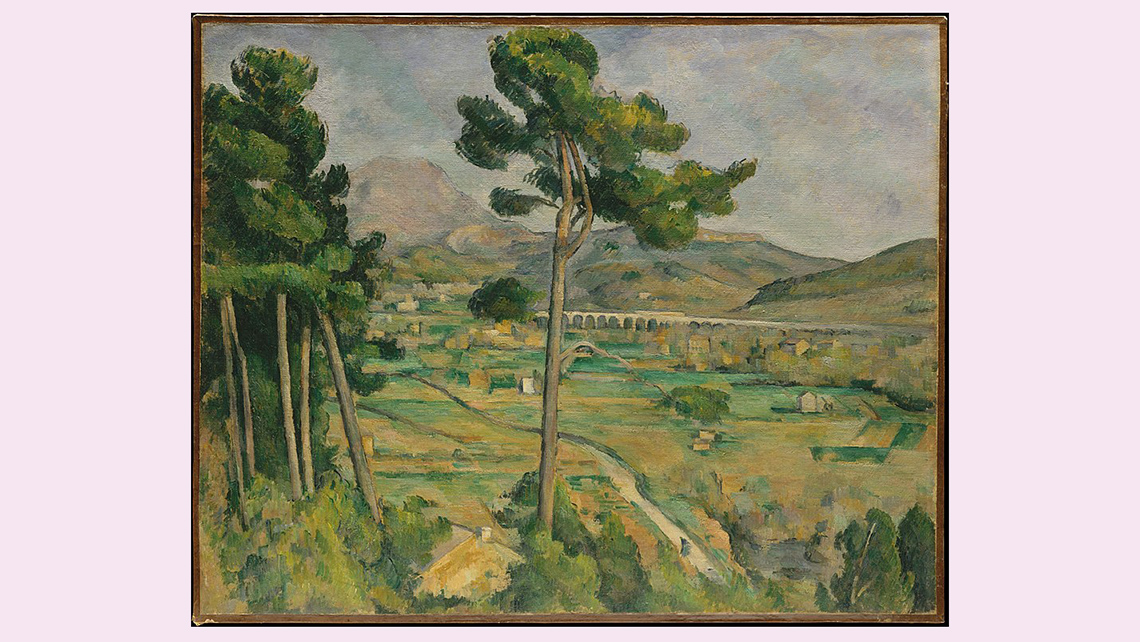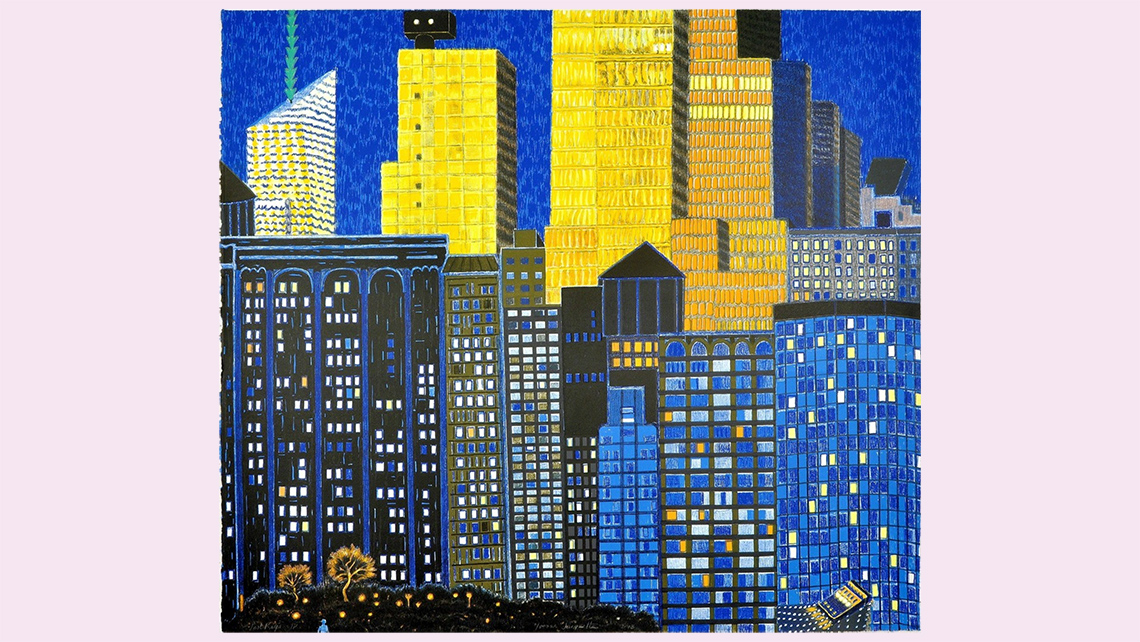Minds On
Let's get started!
Notice and wonder
Explore the following examples of a landscape and a cityscape.
What do you notice about each artwork?
How did the artist create depth?
Press ‘Definition’ to access the meaning of the word depth.
Depth is the apparent distance from the front of an artwork to the back of an artwork. Depth can be created by having a foreground, middle ground, and a background in an artwork.
A carousel of two images. Image 1: Mont Sainte-Victoire and the Viaduct of the Arc River Valley, Paul Cézanne. An image of a landscape painting during the daytime. In the foreground there are tall skinny trees with short branches and tufts of leaves at their top. In the middle ground, there is vegetation and rocks. A river flows beneath a viaduct. In the background, there are mountains and a cloudless sky.
Image 2: Last Rays, Yvonne Jacquette. An image of a colour lithograph or print of a cityscape at night. In the foreground, there is a small horizontal patch of dirt with bright small plants growing out of it. It appears that this cityscape is captured from a hill. In the middle ground there are densely packed buildings with rows of lit and unlit geometric windows. In the background, there are taller buildings that are lit up in bright yellow and white against a dark blue sky.
Action
Get ready, get set…

Fantastic Landscape by Paul Brill, 1598
In the Minds On, we explored an example of landscape art by Paul Cézanne and an example of cityscape art by Yvonne Jacquette. Landscape art often includes organic shapes as it is meant to represent what is found in nature. Cityscapes often include geometric shapes as they represent human-made buildings and other structures. In both examples, the artists added depth to their work by creating overlapping planes called the foreground, middle ground, and background.
Press the following tabs to access the definitions of organic, geometric, and depth.
Foreground
The foreground is generally closer to the bottom of the artwork. The objects in the foreground are made larger in relation to the other objects in the artwork. This provides the audience with the perspective that the objects in the foreground are closer. The images in the foreground may also contain more detail.

Middle ground
The middle ground is the space between the foreground and the background. The middle ground appears to be in the middle of a landscape or cityscape. The objects have some detail but are not as detailed than in the foreground.

Background
The background is the area that appears to be the furthest away. It gives some context to the scene and provides clues about the location of the artwork. Objects in the background are smaller in relation to the objects in the foreground and middle ground. They also contain less details. Oftentimes, objects in the background are behind the other objects in the artwork.

Let’s return to artwork from the Minds On: Paul Cézanne’s landscape painting Mont Sainte-Victoire and the Viaduct of the Arc River Valley.
Identify the foreground, middle ground and background in the painting. Record your answer using a method of your choice.

An image of a landscape painting during the daytime. In the foreground there are tall skinny trees with short branches and tufts of leaves at their top. In the middle ground, there is vegetation and rocks. A river flows beneath a viaduct. In the background, there are mountains and a cloudless sky.
Press ‘Answer’ to access the foreground, middle ground, and background of Cezanne’s painting.

An image of a landscape painting marked to identify the foreground, middle ground and background. The foreground includes tall skinny trees with short branches and tufts of leaves at their top. The middle ground includes vegetation and rocks and a river which flows beneath a viaduct. The background includes mountains and a cloudless sky.
foreground (orange), middle ground (pink area), background (blue area)
Next, identify the foreground, middle ground, and background in Yvonne Jacquette’s print Last Rays. Record your answer using a method of your choice.

An image of a colour lithograph or print of a cityscape at night. In the foreground, there is a small horizontal patch of dirt with bright small plants growing out of it. It appears that this cityscape is captured from a hill. In the middle ground there are densely packed buildings with rows of lit and unlit geometric windows. In the background, there are taller buildings that are lit up in bright yellow and white against a dark blue sky.
Press ‘Answer’ to access the foreground, middle ground, and background of Yvonne Jacquette’s artwork.

An image of a cityscape colour lithograph with labels to indicate the foreground, middle ground and background. The foreground includes a small horizontal patch of dirt with bright small plants growing out of it. The middle ground includes there are densely packed buildings with rows of lit and unlit geometric windows. The background includes taller buildings that are lit up in bright yellow and white against a dark blue sky.
Go!
Create your own landscape or cityscape art

It’s time to plan your own landscape or cityscape artwork. Follow the steps below, and answer the questions provided to begin your plan. You may record your ideas using a method of your choice.
Press the following tabs to follow the steps for creating your own landscape or cityscape artwork.
Consider which style of artwork you would like to explore. You might select a landscape or cityscape based on a space or location that you have already experienced, or you might select a landscape or cityscape that you would like to explore in the future.
Note: You may use a photograph or a digital image for inspiration.
Consider why you have chosen your specific space or location. What do you enjoy about it? Is this space or location important to you? If yes, explain your thoughts
Does the space include natural objects or human-made structures? If so, which types of shapes would you include in your artwork?
Press ‘Hint’ to access a hint about organic and geometric shapes.
If the space has more natural objects (e.g., trees, lakes, etc.) it might include more organic shapes.
If the space has more human-made structures (i.e., buildings) it might include more geometric shapes.
Consolidation
Putting it all together

Using your notes from the Go! section, consider how you will use foreground, middle ground, and background to create depth in your artwork.
Materials Needed
Materials you might need
Possible materials you might need for this learning activity:
- drawing tools (i.e. pencils, pens, crayons, markers, paint)
- paper, cardboard, etc
- scrap paper, old magazines, newpaper, etc
- scissors and glue
Student Success
Exploring digital creation options
When you are considering digital creation options, explore the variety of digital applications available!
Note to teachers: See your teacher guide for collaboration tools, ideas and suggestions.
Safety
Before you begin, consider these safety precautions:

Now it’s your turn to create! Consider the following options to check out a variety of methods to create your art. Choose one option to try out.
Option 1: Description
Create a detailed description of what you will include in the foreground, middle ground, and background of your artwork.
How will you begin to organize the three planes?
What kind of details will you include in each plane?
You may record your description using a method of your choice.
Option 2: Digital
Use a digital drawing tool of your choice to create a cityscape or landscape which includes a foreground, middle ground, and background. You might choose to begin with the background and then layer the objects of your middle ground and foreground on top.
Option 3: Materials
Possible materials:
- drawing tools (i.e pencil, pens, crayons, markers, paint)
- paper, cardboard, etc.
- scrap paper, old magazines, newspaper etc.
- scissors and glue
Step 1
What do you want to include in your background?
Begin at the top of your paper or cardboard and use your drawing tools to fill it so that 1/3 includes your background. You may also to use scrap paper to create a collage.
Press ‘Definition’ to access a definition of collage.
Collage is a form of art in which a variety of unrelated materials (e.g. photographs, fabric, found objects, digital images) are arranged on a flat background.
Landscape
For example, you may choose to create a night sky background.

An image that is broken down into three sections. The top section is filled in with an image of the night sky. The other two sections following it are blank.
Cityscape
For example, you may choose to create a night sky background with the tops of the buildings.

An image that is broken down into three sections. The top section is filled in with an image of the night sky and the tops of buildings. The other two sections following it are blank.
Step 2
What is in the middle ground?
Fill the middle section with details in the middle ground.
Landscape
For example, you may choose to add a river to your middle ground with a reflection of the moon and stars.

An image that has been broken down into three sections. The top section is filled with the night sky. The middle section has a river with the reflection of the moon and stars. The final section is blank.
Cityscape
For example, you may choose to add two rows of overlapping buildings.

An image that has three sections. The first section has an image of a night sky background with the tops of some buildings. The middle section has two rows of overlapping buildings. The third section is blank.
Step 3
What is in the foreground?
The items in the foreground will be largest and have the most amount of detail.
Landscape
For example, you may choose to add the silhouette of trees in the foreground.
Press ‘Definition’ to access the definition of the word silhouette.
A silhouette is the outline and shape of a person, animal, object, or scene created from a single colour.

An image that has been broken down into three sections. The top section is filled with the night sky. The middle section has a river with the reflection of the moon and stars. The final section has a silhouette of trees.
Cityscape
For example, you may choose to add a viaduct in the foreground.
Press ‘Definition’ to access a definition of the word viaduct.
A viaduct is a type of bridge. It is made of arches, piers, and columns which support a railway or road.

An image that has three sections. The first section has an image of a night sky background with the tops of some buildings. The middle section has two rows of overlapping buildings. The third section has an image of a viaduct.
Portfolio
Track your progress
Think about the process you have gone through to create your landscape or cityscape.
Does it clearly show foreground, middle ground, and background?
Were you able to incorporate things that are special or that you enjoy in that place?
Is there a part you would do differently if you were to try it again?
If possible, share your beautiful art with a peer. If you have a portfolio, you can put your art there to track your progress over time.
Reflection
As you read through these descriptions, which sentence best describes how you are feeling about your understanding of this learning activity? Press the button that is beside this sentence.
I feel…
Now, record your ideas using a voice recorder, speech-to-text, or writing tool.

